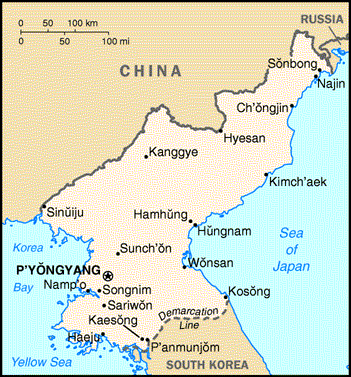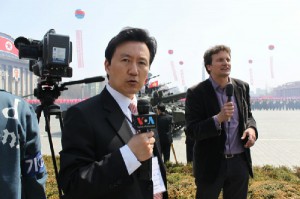
Challenges to U.S. Public Diplomacy in North Korea
Since its establishment in 1948, the United States has never had a formal diplomatic relationship with North Korea. As North Korea continues to expand its nuclear weapons program and adopts an increasingly belligerent rhetoric one must ask: can the U.S. make effective use of public diplomacy to thaw tensions with North Korea? If so, what are the barriers to public diplomacy that the U.S. has to overcome to increase its outreach inside North Korea?
As the traditional avenues of diplomatic relations remain closed, the U.S. has been forced to focus its efforts more towards influencing public opinion within North Korea itself, hoping to garner more change in the long term. But this is no easy task. The North Korean government maintains complete control of all media outlets within the country, ensuring that all news comes from its own Korean Central News Agency. Coming as no surprise, North Korea ranks near the bottom on the 2013 Reporters Without Borders World Press Freedom Index.
Only top level government elites have access to the global internet, while a completely closed off state run intranet provides extremely limited access to the minimally-connected general population. Furthermore, it is illegal for a North Korean citizen to receive radio and television broadcasts from foreign sources. Because much of public diplomacy outreach to closed off countries relies on access to these various media outlets, these barriers greatly inhibit the effectiveness of U.S. public diplomacy inside North Korea.
This is not to say that there have not been efforts by both private sector and government to breach North Korea’s restrictive barriers.
 In its FY2014 Budget request, the Broadcasting Board of Governors requested funds to build a new mediumwave radio transmitter near the South Korean border with an aim to broadcast into North Korea. While these transmissions are likely to attract jamming from the North, the BBG argues that mediumwave transmissions are less susceptible to jamming than shortwave, allowing them to potentially reach a much larger audience. Mediumwave radios are also much more commonly available in North Korea. Furthermore, a new radio tower in this strategic position along the border will permit a wider range of transmission across the majority of the country.
In its FY2014 Budget request, the Broadcasting Board of Governors requested funds to build a new mediumwave radio transmitter near the South Korean border with an aim to broadcast into North Korea. While these transmissions are likely to attract jamming from the North, the BBG argues that mediumwave transmissions are less susceptible to jamming than shortwave, allowing them to potentially reach a much larger audience. Mediumwave radios are also much more commonly available in North Korea. Furthermore, a new radio tower in this strategic position along the border will permit a wider range of transmission across the majority of the country.
In 2008, in the first cultural visit to North Korea by the United States since the Korean War, the New York Philharmonic traveled to North Korea and played a concert in the East Pyongyang Grand Theatre. The concert was especially remarkable because of its live broadcast across all North Korea via the Korean Central Television. Playing both Korean and American music, the concert was viewed as an important first step towards better relations between the U.S. and North Korea.
Other private institutions seek to educate and create awareness about North Korea within the U.S. as a way to promote public diplomacy efforts in North Korea. For example, the Defense Forum Foundation sponsors radio outreach in North Korea, the National Committee on North Korea works to promote peace and improve the lives of North Korean citizens through understanding and relationship building and the Korean American Sharing Program provides aid and education to North Korean citizens.
Yet in North Korea, it is not only difficult to ensure that public diplomacy efforts reach their desired audience but also extremely challenging to measure the effect that these efforts have in creating influence—a primary goal of public diplomacy—especially without a diplomatic presence on the ground.
“A Quiet Opening: North Koreans in a Changing Media Environment” is a 2012 study conducted by InterMedia with sponsorship by the U.S. State Department that assesses the media environment within North Korea and more particularly the access North Koreans have to foreign media. InterMedia finds that while the North Korean government attempts to maintain absolute control over its citizens’ access to media, it is becoming increasingly difficult for it to do so. With increased access to technology such as DVD players, TV and radio the study suggests that North Koreans have more access to foreign media now than ever before.
This could present an opportunity for the international community to exploit.
The InterMedia study indicates that as more outside media is introduced into North Korea, North Koreans gain a more positive outlook of the outside world. This relationship is especially interesting to note when looking at North Korea from a public diplomacy standpoint. The study demonstrates that there is a role that public diplomacy can play in North Korea to catalyze social change and advance U.S. foreign policy objectives. America should be mindful of this, and engage in efforts to increase North Korean access to information. Though media outreach into North Korea may not have a very evident short-term effect, over a longer period of time, properly directed outreach as a component of a coordinated overall smart power strategy may be able to help catalyze change.






[…] Challenges to U.S. Public Diplomacy in North Korea […]
[…] Challenges to U.S. Public Diplomacy in North Korea Christian Mull […]
[…] Challenges to U.S. Public Diplomacy in North Korea […]